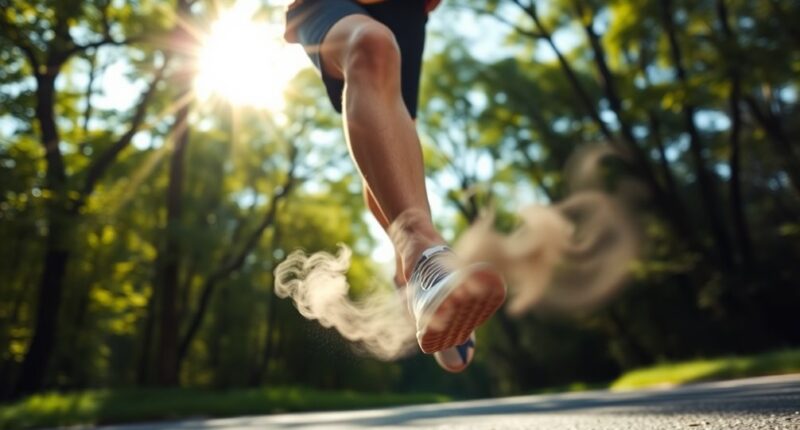To enhance your running performance, focus on proper breathing techniques. Try diaphragmatic breathing to strengthen your lungs and use rhythmic patterns like the 3:2 inhale-exhale to synchronize with your stride. Breathing fresh air helps boost your energy, so select routes away from pollution. If you have asthma, be mindful of triggers and consider mouth breathing during intense efforts. By mastering these techniques, you'll find running becomes more enjoyable and efficient. Find out how to refine these skills further.
Key Takeaways
- Diaphragmatic breathing strengthens the respiratory system, increasing oxygen intake and enhancing running efficiency.
- Establish rhythmic breathing patterns, such as 3:2 or 2:1, to optimize breath with foot strikes for improved performance.
- Use nasal breathing during moderate runs to maximize oxygen intake and maintain energy levels.
- Monitor air quality and choose running times that minimize exposure to pollutants, especially for asthma management.
- Practice structured breathing exercises regularly to enhance lung capacity and overall running stamina.
Importance of Breath in Running

Breathing is essential to your running performance, as it provides the oxygen your muscles need while expelling carbon dioxide. Proper breath management directly impacts your efficiency and stamina during runs.
By mastering breathing techniques, you can guarantee a steady intake of oxygen, which keeps fatigue at bay. It's important to focus on your inhale, as it requires more effort than exhaling.
Developing a rhythmic breathing pattern that synchronizes with your running gait can optimize oxygen intake, enhancing your overall performance. Additionally, maintaining optimal comfort during your runs can significantly improve your endurance and overall experience.
Challenges of Breathing While Running

When you start running, your body demands more oxygen, which can create initial breathing challenges.
You might notice that muscle coordination issues can make it harder to breathe efficiently at first.
However, with a little time, your body typically adjusts, easing those early struggles. Additionally, practicing mindfulness techniques can help improve your overall breathing efficiency while on the run.
Oxygen Demand Increase
As you push your limits during a run, your body demands considerably more oxygen, leading to an increased breathing rate that can be challenging to manage.
During intense exercise, your breathing rate may soar to over 40 breaths per minute, compared to the normal 12-20 breaths at rest. This heightened oxygen demand can result in inadequate supply, causing lactic acid buildup in your muscles, which leads to cramps and fatigue that hinder performance.
However, consistent training enhances your exercise tolerance, improving your efficiency in oxygen delivery and utilization. Incorporating diaphragmatic breathing techniques can help you adapt, allowing breathlessness to subside after the first 5-10 minutes of activity, so you can maintain better performance with less perceived exertion.
Muscle Coordination Issues
An increase in oxygen demand during intense running can lead to muscle coordination issues that complicate effective breathing. If your breath doesn't sync with your running gait, you might find it harder to catch your breath, leading to inefficient oxygen delivery and increased fatigue.
To combat this, incorporate breathing exercises into your routine; they can help improve your running by promoting better coordination. Additionally, consistent training enhances your muscle coordination, allowing for more efficient oxygen utilization. Pre-run activities like foam rolling can also prepare your muscles, making it easier to be active with less discomfort. By addressing these muscle coordination issues, you'll be able to maximize your performance and fuel your body effectively. Moreover, maintaining a balanced diet can provide the necessary nutrients to support your energy levels during runs.
Initial Breathing Challenges
Breathing challenges often hit runners within the first few minutes of their workout, leaving you feeling breathless and gasping for air.
During this time, your body requires more oxygen to enter the muscles, leading to initial breathing challenges. These issues usually resolve within 5-10 minutes as your body adapts, but improper techniques can hinder your progress.
Here are some factors to reflect upon for efficient breathing:
- Breathing Pattern: Establish a consistent rhythm to enhance oxygen intake.
- Body Weight: Excess weight can strain breathing; focus on maintaining a healthy weight.
- Breathing Techniques: Implement proper techniques, like diaphragmatic breathing, to improve lung capacity.
Basics of Breathing Techniques

Mastering effective breathing techniques can greatly enhance your running performance. Start by practicing diaphragmatic breathing, which strengthens your respiratory muscles and boosts oxygen intake.
Incorporating nasal breathing can also maximize your oxygen intake, vital for meeting higher energy demands. Establishing a rhythmic breathing pattern, like a 3:2 inhale-exhale ratio, helps align your breath with foot strikes, improving stability and comfort.
Remember, maintaining good posture is essential; it allows for ideal lung expansion and better breath control. Exploring various techniques, such as equal breathing or pursed-lips breathing, can enhance your respiratory efficiency and minimize breathlessness during runs. Additionally, utilizing essential oils like eucalyptus oil can promote easier breathing and support your respiratory health during intense workouts.
Diaphragmatic Breathing and Its Benefits

Diaphragmatic breathing, often referred to as belly breathing, offers a powerful way to enhance your running performance. By engaging your diaphragm, you can greatly improve oxygen delivery to your muscles, which is essential during intense runs.
Here are some key benefits of this technique:
- Increased Lung Capacity: Strengthening your respiratory muscles helps you take in more air, improving endurance.
- Reduced Breathlessness: Practicing this method lowers feelings of breathlessness, allowing you to maintain a steady pace.
- Enhanced Comfort: Deeper inhalations and longer exhalations decrease the likelihood of side stitches and tension in your shoulders.
Incorporating diaphragmatic breathing into your routine can lead to better overall running performance and a more enjoyable experience on the track or trail. Additionally, understanding advance directives can help ensure your health preferences are respected during any medical emergencies that may arise while running.
Rhythmic Breathing Patterns for Efficiency

To maximize your running efficiency, try matching your breath with your foot strikes.
Using techniques like the 3:2 inhale-exhale pattern can help you take in more oxygen and reduce impact stress. Additionally, understanding the importance of long-term financial planning can help you allocate resources for proper health and wellness as you engage in physical activities.
Matching Breath and Steps
When you align your breath with your foot strikes, you can considerably enhance your running efficiency. Establishing a consistent rhythm not only optimizes your oxygen intake but also minimizes breathlessness during your runs.
Here are three effective breathing patterns to try:
- 3:2 Pattern: Inhale for three steps and exhale for two. This helps stabilize your core and synchronize with your foot strikes.
- 2:1 Pattern: Use this during high-intensity runs, inhaling for two steps and exhaling for one. It boosts your oxygen supply when you need it most.
- Experimentation: Adjust your breathing pattern based on your pace. Finding the right rhythm can improve endurance and reduce fatigue, leading to a smoother, more efficient run. Additionally, incorporating stress management techniques can enhance your overall running experience by promoting relaxation and focus.
Inhale-Exhale Timing Techniques
Mastering the timing of your inhale-exhale cycle can greatly enhance your running efficiency. By employing rhythmic breathing patterns, you can synchronize your breath with your foot strikes.
The 3:2 breathing pattern is effective; inhale through your nose for three steps and exhale through your mouth for two. This method maximizes oxygen delivery while minimizing core instability.
For higher intensity runs, try the 2:2 breathing cycle, inhaling and exhaling over two steps each. Adjusting your breath-to-step ratio based on your pace will help manage breathlessness and improve running efficiency.
Slower runs can even benefit from a 4:4 pattern. Practicing these techniques can lead to improved endurance and performance during long distances, making each run more enjoyable. Additionally, incorporating better sleep techniques can further enhance your overall running performance.
Inhale Fresh Air for Optimal Performance

Inhaling fresh air is essential for optimizing your running performance, as it greatly boosts oxygen intake and sustains your energy levels.
To enhance your respiratory efficiency and lung function, consider these tips:
- Choose your timing: Run when traffic is minimal to guarantee cleaner air.
- Select your routes: Opt for paths away from congested roads to reduce exposure to pollutants.
- Be air quality aware: Monitor air quality before heading out to improve your endurance and overall experience. Additionally, using an air purifier can help maintain cleaner indoor air when training indoors.
Tips for Managing Asthma During Runs

Managing asthma during runs can feel challenging, but with the right strategies, you can enjoy a more comfortable experience.
Start by warming up gradually to prepare your lungs and reduce the likelihood of asthma symptoms. Monitor environmental conditions like pollen counts and air quality, choosing to run when they're least likely to trigger your symptoms.
During high-intensity runs, practice mouth breathing to maximize oxygen intake, allowing for greater airflow. Incorporate specific breathing techniques, such as diaphragmatic breathing, to strengthen your respiratory muscles and improve lung function.
Always consult your healthcare provider for personalized asthma management strategies to guarantee your running performance stays on track while keeping your health a priority.
Additional Resources for Breath Training

How can you enhance your breath training to improve your running performance? Consider incorporating these additional resources into your routine:
- Breathing Exercises: Practice diaphragmatic breathing and box breathing to boost lung capacity and manage anxiety, which can enhance focus during runs.
- Technology: Use apps or devices that guide you through structured breathing sessions. They can help you maintain consistent practice and improve your breath control.
- Patterned Breathing: Implement techniques like the 2:2 or 3:2 breathing patterns. These strategies synchronize your breath with your running pace, maximizing athletic performance.
Frequently Asked Questions
What Breathing Techniques Help You Run Faster?
To run faster, you can focus on rhythmic breathing, like a 3-step inhale and 2-step exhale, to sync your breath with your foot strikes.
Try diaphragmatic breathing to boost lung capacity and endurance, and switch between nasal and mouth breathing based on your intensity.
Patterned breathing, like a 2:2 ratio, helps maintain focus.
Finally, pursed-lips breathing can slow your rate and improve oxygen absorption during high-intensity efforts.
What Is the 4 7 8 Breath Method?
The 4-7-8 breath method is a simple technique you can use to promote relaxation and reduce stress.
You inhale through your nose for 4 seconds, hold your breath for 7 seconds, and then exhale through your mouth for 8 seconds.
This method helps calm your nervous system and improves lung capacity over time.
Practicing it at least twice a day can enhance your focus and mental clarity, making it easier to manage anxiety.
What Are the 3 Breathing Techniques of a Runner?
So, you think breathing's overrated? Think again! Runners swear by three key techniques.
First, there's diaphragmatic breathing, which gets your belly involved—feel free to channel your inner whale.
Next up is rhythmic breathing; just sync it with your foot strikes—who knew running could be a dance?
Finally, equal breathing balances your inhale and exhale.
Trust me, these techniques could turn you into a running marvel, not just a gasping fish out of water!
What Is the Best Breathing Pattern for Running?
The best breathing pattern for running really depends on your pace and intensity. For a comfortable jog, you might try a 3:2 ratio, inhaling for three steps and exhaling for two.
If you're pushing harder, a 2:2 cycle can help manage breathlessness. For longer runs, a 4:4 pattern keeps your breathing relaxed.
Ultimately, you should find a rhythm that feels natural, allowing you to run more efficiently and enjoyably.
Conclusion
Incorporating effective breathing techniques can truly transform your running experience. Coincidentally, as you focus on your breath, you'll notice not just improved performance, but also a newfound sense of calm during your runs. Whether it's mastering diaphragmatic breathing or finding your perfect rhythm, the right techniques can make all the difference. So, as you hit the pavement, remember that each breath is not just a necessity, but a powerful tool to elevate your running game.









